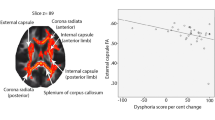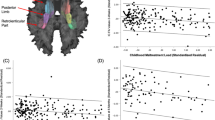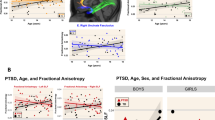Abstract
Prior structural imaging studies of post-traumatic stress disorder (PTSD) have observed smaller volumes of the hippocampus and cingulate cortex, yet little is known about the integrity of white matter connections between these structures in PTSD samples. The few published studies using diffusion tensor imaging (DTI) to measure white matter integrity in PTSD have described individuals with focal trauma rather than chronically stressed individuals, which limits generalization of findings to this population; in addition, these studies have lacked traumatized comparison groups without PTSD. The present DTI study examined microstructural integrity of white matter tracts in a sample of highly traumatized African-American women with (n=25) and without (n=26) PTSD using a tract-based spatial statistical approach, with threshold-free cluster enhancement. Our findings indicated that, relative to comparably traumatized controls, decreased integrity (measured by fractional anisotropy) of the posterior cingulum was observed in participants with PTSD (p<0.05). These findings indicate that reduced microarchitectural integrity of the cingulum, a white matter fiber that connects the entorhinal and cingulate cortices, appears to be associated with PTSD symptomatology. The role of this pathway in problems that characterize PTSD, such as inadequate extinction of learned fear, as well as attention and explicit memory functions, are discussed.
Similar content being viewed by others

Log in or create a free account to read this content
Gain free access to this article, as well as selected content from this journal and more on nature.com
or
References
Abe O, Yamasue H, Kasai K, Yamada H, Aoki S, Iwanami A et al (2006). Voxel-based diffusion tensor analysis reveals aberrant anterior cingulum integrity in posttraumatic stress disorder due to terrorism. Psychiatry Res 146: 231–242.
Baur V, Bruhl AB, Herwig U, Eberle T, Rufer M, Delsignore A et al (2011). Evidence of frontotemporal structural hypoconnectivity in social anxiety disorder: a quantitative fiber tractography study. Hum Brain Mapp; (e-pub ahead of print).
Beck AT, Steer RA, Brown G (1996). Manual for Beck Depression Inventory II (BDI-II). Psychology: San Antonio, TX.
Binder EB, Bradley RG, Liu W, Epstein MP, Deveau TC, Mercer KB et al (2008). Association of FKBP5 polymorphisms and childhood abuse with risk of posttraumatic stress disorder symptoms in adults. JAMA 299: 1291–1305.
Bradley RG, Binder EB, Epstein MP, Tang Y, Nair HP, Liu W et al (2008). Influence of child abuse on adult depression: moderation by the corticotropin-releasing hormone receptor gene. Arch Gen Psychiatry 65: 190–200.
Bremner JD (2006). Traumatic stress: effects on the brain. Dialogues Clin Neurosci 8: 445–461.
Chen L, Lui S, Wu QZ, Zhang W, Zhou D, Chen HF et al (2011). Impact of acute stress on human brain microstructure: an MR diffusion study of earthquake survivors. Hum Brain Mapp; (e-pub ahead of print).
Chiang MC, Avedissian C, Barysheva M, Toga AW, McMahon KL, de Zubicaray GI et al (2009). Extending genetic linkage analysis to diffusion tensor images to map single gene effects on brain fiber architecture. Med Image Comput Comput Assist Interv 12 (Pt 2): 506–513.
De Bellis MD, Keshavan M, Shifflett H, Iyengar S, Beers SR, Hall J et al (2002). Brain structures in pediatric maltreatment-related PTSD: a sociodemographically matched study. Biol Psychiatry 52: 1066–1078.
Drago V, Babiloni C, Bartres-Faz D, Caroli A, Bosch B, Hensch T et al (2011). Disease tracking markers for Alzheimer's disease at the prodromal (MCI) stage. J Alzheimers Dis 26 (Suppl 3): 159–199.
Falsetti SA, Resnick HS, Resick PA, Kilpatrick DG (1993). The modified PTSD symptom scale: a brief self-report measure of posttraumatic stress disorder. Behav Ther 16: 161–162.
Fani N, Jovanovic T, Ely TD, Bradley B, Gutman D, Tone EB et al (2012a). Neural correlates of attention bias to threat in post-traumatic stress disorder. Biol Psychol 90: 134–142.
Fani N, Tone EB, Phifer J, Norrholm SD, Bradley B, Ressler KJ et al (2012b). Attention bias toward threat is associated with exaggerated fear expression and impaired extinction in PTSD. Psychol Med 42: 533–543.
Fox RJ, Sakaie K, Lee JC, Debbins JP, Liu Y, Arnold DL et al (2012). A validation study of multicenter diffusion tensor imaging: reliability of fractional anisotropy and diffusivity values. AJNR Am J Neuroradiol 33: 695–700.
Gillespie CF, Bradley B, Mercer K, Smith AK, Conneely K, Gapen M et al (2009). Trauma exposure and stress-related disorders in inner city primary care patients. Gen Hosp Psychiatry 31: 505–514.
Goosens KA (2011). Hippocampal regulation of aversive memories. Curr Opin Neurobiol 21: 460–466.
Hartley CA, Phelps EA (2010). Changing fear: the neurocircuitry of emotion regulation. Neuropsychopharmacology 35: 136–146.
Heldt SA, Stanek L, Chhatwal JP, Ressler KJ (2007). Hippocampus-specific deletion of BDNF in adult mice impairs spatial memory and extinction of aversive memories. Mol Psychiatry 12: 656–670.
Hua K, Zhang J, Wakana S, Jiang H, Li X, Reich DS et al (2008). Tract probability maps in stereotaxic spaces: analyses of white matter anatomy and tract-specific quantification. Neuroimage 39: 336–347.
Huang H, Fan X, Williamson DE, Rao U (2011). White matter changes in healthy adolescents at familial risk for unipolar depression: a diffusion tensor imaging study. Neuropsychopharmacology 36: 684–691.
Jackowski AP, Douglas-Palumberi H, Jackowski M, Win L, Schultz RT, Staib LW et al (2008). Corpus callosum in maltreated children with posttraumatic stress disorder: a diffusion tensor imaging study. Psychiatry Res 162: 256–261.
Jenkinson M, Smith S (2001). A global optimisation method for robust affine registration of brain images. Med Image Anal 5: 143–156.
Ji J, Maren S (2007). Hippocampal involvement in contextual modulation of fear extinction. Hippocampus 17: 749–758.
Johnson VE, Stewart W, Smith DH (2012). Axonal pathology in traumatic brain injury. Exp Neurol; (e-pub ahead of print).
Jovanovic T, Norrholm SD, Blanding NQ, Davis M, Duncan E, Bradley B et al (2010). Impaired fear inhibition is a biomarker of PTSD but not depression. Depress Anxiety 27: 244–251.
Jovanovic T, Ressler KJ (2010). How the neurocircuitry and genetics of fear inhibition may inform our understanding of PTSD. Am J Psychiatry 167: 648–662.
Kantarci K, Senjem ML, Avula R, Zhang B, Samikoglu AR, Weigand SD et al (2011). Diffusion tensor imaging and cognitive function in older adults with no dementia. Neurology 77: 26–34.
Karl A, Schaefer M, Malta LS, Dorfel D, Rohleder N, Werner A (2006). A meta-analysis of structural brain abnormalities in PTSD. Neurosci Biobehav Rev 30: 1004–1031.
Keedwell PA, Chapman R, Christiansen K, Richardson H, Evans J, Jones DK (2012). Cingulum white matter in young women at risk of depression: the effect of family history and anhedonia. Biol Psychiatry; (e-pub ahead of print).
Kim MJ, Lyoo IK, Kim SJ, Sim M, Kim N, Choi N et al (2005). Disrupted white matter tract integrity of anterior cingulate in trauma survivors. Neuroreport 16: 1049–1053.
Kim SJ, Jeong DU, Sim ME, Bae SC, Chung A, Kim MJ et al (2006). Asymmetrically altered integrity of cingulum bundle in posttraumatic stress disorder. Neuropsychobiology 54: 120–125.
Kochunov P, Glahn DC, Lancaster JL, Winkler AM, Smith S, Thompson PM et al (2010). Genetics of microstructure of cerebral white matter using diffusion tensor imaging. Neuroimage 53: 1109–1116.
Liberzon I, Martis B (2006). Neuroimaging studies of emotional responses in PTSD. Ann NY Acad Sci 1071: 87–109.
Mandl RC, Rais M, van Baal GC, van Haren NE, Cahn W, Kahn RS et al (2012). Altered white matter connectivity in never-medicated patients with schizophrenia. Hum Brain Mapp; (e-pub ahead of print).
Milad MR, Pitman RK, Ellis CB, Gold AL, Shin LM, Lasko NB et al (2009). Neurobiological basis of failure to recall extinction memory in posttraumatic stress disorder. Biol Psychiatry 66: 1075–1082.
Morell P, Norton WT (1980). Myelin. Sci Am 242: 88–90, 92, 96 passim.
Norrholm SD, Jovanovic T, Olin IW, Sands LA, Karapanou I, Bradley B et al (2011). Fear extinction in traumatized civilians with posttraumatic stress disorder: relation to symptom severity. Biol Psychiatry 69: 553–563.
Phan KL, Orlichenko A, Boyd E, Angstadt M, Coccaro EF, Liberzon I et al (2009). Preliminary evidence of white matter abnormality in the uncinate fasciculus in generalized social anxiety disorder. Biol Psychiatry 66: 691–694.
Price G, Cercignani M, Parker GJ, Altmann DR, Barnes TR, Barker GJ et al (2008). White matter tracts in first-episode psychosis: a DTI tractography study of the uncinate fasciculus. Neuroimage 39: 949–955.
Radulovic J, Tronson NC (2010). Molecular specificity of multiple hippocampal processes governing fear extinction. Rev Neurosci 21: 1–17.
Schuff N, Zhang Y, Zhan W, Lenoci M, Ching C, Boreta L et al (2011). Patterns of altered cortical perfusion and diminished subcortical integrity in posttraumatic stress disorder: an MRI study. Neuroimage 54 (Suppl 1): S62–S68.
Schwartz AC, Bradley RL, Sexton M, Sherry A, Ressler KJ (2005). Posttraumatic stress disorder among African Americans in an inner city mental health clinic. Psychiatr Serv 56: 212–215.
Shin LM, Handwerger K (2009). Is posttraumatic stress disorder a stress-induced fear circuitry disorder? J Trauma Stress 22: 409–415.
Shin LM, Rauch SL, Pitman RK (2006). Amygdala, medial prefrontal cortex, and hippocampal function in PTSD. Ann NY Acad Sci 1071: 67–79.
Smith SM (2002). Fast robust automated brain extraction. Hum Brain Mapp 17: 143–155.
Smith SM, Jenkinson M, Johansen-Berg H, Rueckert D, Nichols TE, Mackay CE et al (2006). Tract-based spatial statistics: voxelwise analysis of multi-subject diffusion data. Neuroimage 31: 1487–1505.
Smith SM, Jenkinson M, Woolrich MW, Beckmann CF, Behrens TE, Johansen-Berg H et al (2004). Advances in functional and structural MR image analysis and implementation as FSL. Neuroimage 23 (Suppl 1): S208–S219.
Smith SM, Nichols TE (2009). Threshold-free cluster enhancement: addressing problems of smoothing, threshold dependence and localisation in cluster inference. Neuroimage 44: 83–98.
Tavanti M, Battaglini M, Borgogni F, Bossini L, Calossi S, Marino D et al (2012). Evidence of diffuse damage in frontal and occipital cortex in the brain of patients with post-traumatic stress disorder. Neurol Sci 33: 59–68.
Teicher MH, Dumont NL, Ito Y, Vaituzis C, Giedd JN, Andersen SL (2004). Childhood neglect is associated with reduced corpus callosum area. Biol Psychiatry 56: 80–85.
Thomaes K, Dorrepaal E, Draijer N, de Ruiter MB, van Balkom AJ, Smit JH et al (2010). Reduced anterior cingulate and orbitofrontal volumes in child abuse-related complex PTSD. J Clin Psychiatry 71: 1636–1644.
Woon FL, Sood S, Hedges DW (2010). Hippocampal volume deficits associated with exposure to psychological trauma and posttraumatic stress disorder in adults: a meta-analysis. Prog Neuropsychopharmacol Biol Psychiatry 34: 1181–1188.
Zhang L, Zhang Y, Li L, Li Z, Li W, Ma N et al (2011). Different white matter abnormalities between the first-episode, treatment-naive patients with posttraumatic stress disorder and generalized anxiety disorder without comorbid conditions. J Affect Disord 133: 294–299.
Acknowledgements
We thank the participants who made this work possible, as well as the staff of the Grady Trauma Project, particularly Allen W Graham, Angelo Brown, Amreen Dharani, Jennifer S Davis, Jennifer Winkler, Sarah Spann, and William Holland. We thank Jaemin Shin for his valuable assistance with data analysis, and the Georgia State University-Georgia Institute of Technology Center for Advanced Brain Imaging for data support. This work was primarily supported by National Institutes of Mental Health (R01MH071537 to KJR) and (F32MH095456 to NF; co-mentors: TZK and KJR). Support was also received from PHS Grant UL1 RR025008 from the Clinical and Translational Science Award program, National Institutes of Health, National Center for Research Resources, and the Burroughs Wellcome Fund (KJR). Dr Fani and Dr Ressler's work was funded by the NIH, as noted above.
Author information
Authors and Affiliations
Corresponding author
Ethics declarations
Competing interests
The authors declare no conflict of interest.
PowerPoint slides
Rights and permissions
About this article
Cite this article
Fani, N., King, T., Jovanovic, T. et al. White Matter Integrity in Highly Traumatized Adults With and Without Post-Traumatic Stress Disorder. Neuropsychopharmacol 37, 2740–2746 (2012). https://doi.org/10.1038/npp.2012.146
Received:
Revised:
Accepted:
Published:
Issue date:
DOI: https://doi.org/10.1038/npp.2012.146
Keywords
This article is cited by
-
Aberrant white matter microstructure evaluation by automated fiber quantification in typhoon-related post-traumatic stress disorder
Brain Imaging and Behavior (2023)
-
Internal capsule microstructure mediates the relationship between childhood maltreatment and PTSD following adulthood trauma exposure
Molecular Psychiatry (2023)
-
The relationship between chronic PTSD, cortical volumetry and white matter microstructure among Australian combat veterans
Military Medical Research (2022)
-
Cortical complexity in world trade center responders with chronic posttraumatic stress disorder
Translational Psychiatry (2021)
-
Altered white matter microstructural organization in posttraumatic stress disorder across 3047 adults: results from the PGC-ENIGMA PTSD consortium
Molecular Psychiatry (2021)


